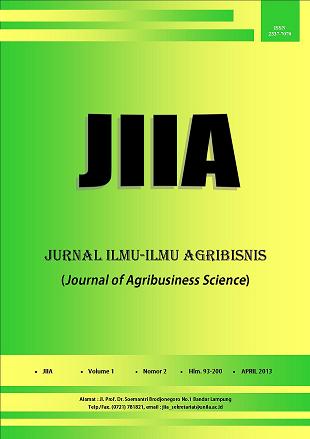TINGKAT KEPUASAN DAN LOYALITAS KONSUMEN GULAKU DI KOTA BANDAR LAMPUNG
DOI:
https://doi.org/10.23960/jiia.v1i2.241 Abstract View: 1886
Abstract View: 1886
Abstract
This study aims to determine the level of satisfaction and consumer loyalty of Gulaku in Bandar Lampung, and to know the effect of the marketing mix to the level of customer satisfaction and loyalty of Gulaku. This research was conducted in June 2012, involving 66 housewives. The study sites were 3 modern markets (Chandra, Giant, and Hypermart) and 3 tradisional markets (Kangkung, Way Halim, and Tugu). The analysis tools were Importance Performance Analysis (IPA), Customer Satisfaction Index (CSI), the analysis of switcher buyer, habitual buyer, satisfied buyer, liking the brand, committed buyer and structural equation models (SEM). The research result showed that the level of customer satisfaction of Gulaku in Bandar Lampung in the category of very satisfied with the value of CSI 81.86% categorized as loyal consumer. The average value of IPA for the level of performance of Gulaku was 3,98 and the level of interest of Gulaku was 4,08. Using SEM analysis, it showed that the marketing mix did not significantly affect the level of customer satisfaction and customer loyalty of Gulaku.
Keywords: CSI, customer, gulaku, IPA, loyalty, satisfaction, SEM
Downloads
Downloads
Published
How to Cite
Issue
Section
License
Authors who publish with this journal agree to the following terms:
Authors retain copyright and grant the journal right of first publication with the work simultaneously licensed under a Creative Commons Attribution License that allows others to share the work with an acknowledgement of the work's authorship and initial publication in this journal.
Authors are able to enter into separate, additional contractual arrangements for the non-exclusive distribution of the journal's published version of the work (e.g., post it to an institutional repository or publish it in a book), with an acknowledgement of its initial publication in this journal.
Authors are permitted and encouraged to post their work online (e.g., in institutional repositories or on their website) prior to and during the submission process, as it can lead to productive exchanges, as well as earlier and greater citation of published work (See The Effect of Open Access).














